
30 April is May Eve, marking the advent of May Day and the beginning of the ancient Celtic festival of Beltane. Beltane begins at dusk on 30 April and is matched by its German counterpart, Walpurgis Nacht, or St Walpurga’s Night. May Day marks the astronomical half-way point between the spring equinox and the summer solstice (in the northern hemisphere.)
St Walpurga was born in Crediton in Devon, but travelled widely as a missionary in the service of her uncle St Boniface, and eventually became abbess of a monastery in Heidenheim in modern Bavaria, where she died 25 February 777 or 779. She was canonized 1 May 870.
Walpurga is reputed to protect sailors in storms at sea, thanks to a miracle when she was sailing to Germany and a terrible storm broke out, and she knelt on deck and prayed and the storm cleared as if by magic…Interestingly, Walpurga is also a protector against witchcraft.… And yet, interestingly, Walpurga is also a protector against witchcraft.
Someone’s prayer is another’s invocation.
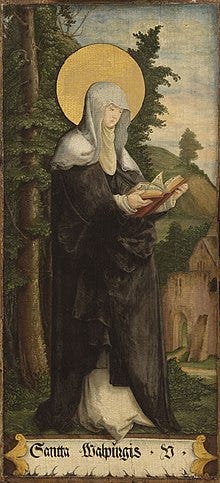
Beltane, ‘the fires of Bel’ began as an ancient fire festival celebrated since at least the Dark Ages if not long before. The celebrations began at dusk on April 30th when great bonfires were lit to welcome the height of spring now associated with the zodiac sign of Taurus the Bull, representing the fertility of spring in full bloom.
Traditionally,” writes Glennie Kindred (in Sacred Celebrations), “all fires in the community were put out and a special fire was kindled for Beltane. This was the ‘balefire’ or the Teineigen, the ‘need fire.’
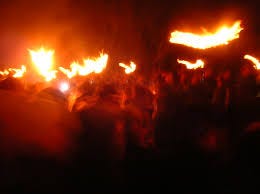
Bel or Belenus (Celtic:, Bright or Powerful One) was a deity associated with pastures, meadows and animal husbandry and other agriculture. He was a fire god rather than a sun god as such, though the sun was used as a common motif in religious imagery.
They walked the cattle between two bonfires in a symbolical purification ritual, protecting them with the smoke from Bel’s fire before putting them out on to the open pastures for the summer. Bonfires were lit on hills, and the smoke was not only considered a magical blessing on the fields, animals, and community, but also created a ‘smokescreen’, literally, between the human and faery realms.
The month of May
May got its modern name from Maia, also called Flora, the Greek goddess of spring. Maia was the oldest of the seven sisters known as the Pleiades, and was the mother of Hermes (Mercury.) The last zodiac sign of Spring, Gemini, is ruled by airy Mercury, as the air fills with butterflies and pollen. The moon will be in Gemini this May Eve, 2025, moving into Cancer early in the morning on May Day, lightening the mood of the current heavy weather of Mars opposite Pluto.
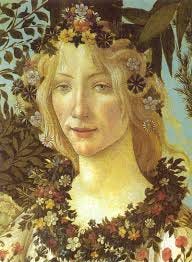
Flora, or Maia by Botticelli
The name ‘May’ has been used in English since about 1430. Before this time the name of this month was spelled Maius or Mai. The Anglo- Saxons called it Tri-Milchus because all that lush new grass meant cows could now be milked three times a day.
The celebration of May Day has been celebrated in the British Isles and through much of Europe as a fertility festival since the Dark Ages, and probably before that, with many stories and superstitions attached. Like Halloween, May Eve and May Day is a magical time of year, liminal, when the veil between different worlds and realities is thinner than at other times of year.
Beltane or Walpurgisnacht is the mirror image, the spring season’s equivalent of Halloween when witches are said to dance at the Devil’s Sabbath. This is a time for ghosts- I recently had a visit from a ghost cat, the first in a long while- but this is also the time of year when folklore suggests you are most likely to meet a supernatural being from the realm of ‘faery.’
The Fae do not like human people, whom they view as destructive (who is to say they do not have a fair point there) and they are famously afraid of iron as the precursor of technology. To ward off the Fae, brandish iron….
Touch wood no good
Touch iron, this you can rely on…
In this sense the Fae could be said to represent the spirit of humanity before the Iron Age. They are not the cute creatures of fairy tale. Encounters are dangerous and do not, whatever you do, go to sleep on a fairy hill at any time, but especially not on May Eve or May Day and especially beware of going to sleep under flowering hawthorn bushes ….
Sex and Scandal. Oo-er.
The Christian church made several attempts to ban May Day festivities outright because of their overtly pagan nature and “lewd” context as an open celebration of male and female sexuality and fertility – ‘a heathenish vanity generally abused to superstition and wickedness.’May Day meant drinking and fighting, another reason for the church’s disapproval, but this in itself harks back to the ancient traditions of the sacrifice of ‘The Green Man’ – a mythical figure representing the eternal battle waged between summer and winter, feast and famine. Many pubs in England are still named The Green Man. And mischievous hobby-horses (‘osses) roamed the streets in search of unsuspecting young ladies to ‘carry away’ for ...erm, undisclosed purposes.
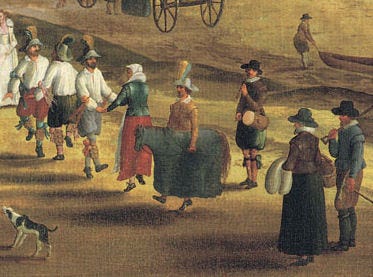
Morris dancers up to no good riding with hobbyhorses, Richmond embankment,1620
Men who had been disappointed in love would make straw men representing their rivals and stick them in bushes. These straw men were, needless to say, deeply unflattering. Fights used to break out when they were discovered and identified, and if the maker was known. And generally, this was exactly what was meant to happen. But what kind of fool admits to recognizing any insulting version of themselves, and saying, “oi, that’s ME! Right, where is he? I know who did this!”
The Puritans (of course) finally did ban May Day celebrations under Oliver Cromwell, but Charles 11 brought them back after the Restoration.

Maypole Dancing goes back at least to the 14th century, but it seems the custom was very old even then, though the dance as we know it today, so pretty and decorative (and tame) -children dancing in village squares, is probably a Victorian re-interpretation.
The maypole is generally assumed to be a phallic symbol, but the Norse peoples connected it with tree worship, and a shared Proto-Germanic culture which is part of the common root culture, constantly visible even today in British life. The Maypole dancing which upset the Church and the Puritans comes down to us from the rites of spring dedicated to Freya. The maypole originally represented a living tree, in particular the giant ash tree Yggdrasil, the great “world tree” of Norse myth, linking the nine worlds of the Norse cosmology including Asgard, land of the gods, Midgard, or Earth and Hel, the underworld.
“Ygg” means terrible. It was on this terrible tree that Odin deliberately chose to hang nine days and nights, thirsty and fasting in exchange for the knowledge of the runes. The Norns sit beneath it, and when every new person is born, carves their names into its bark…and with it, their destiny, although this can change.
The Norns will allow us to rewrite it, unlike the destinies woven by the three Fates of Greek mythology. Just as our natal chart is not so much a map or a cage of predestination, but a song of the spirit, allowing for endless variations on the rhythm and the melody while still “in tune” with that natal song sheet.
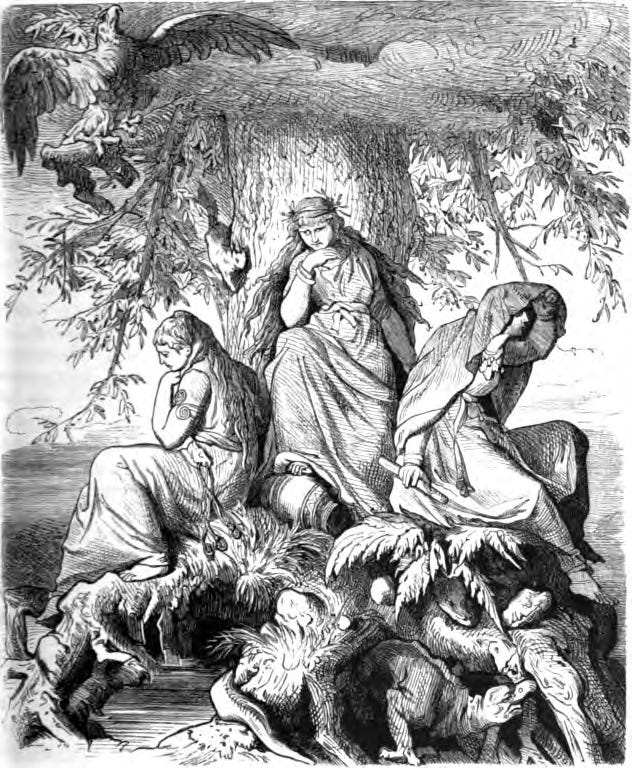
Walpurgis Night
In the Germanic tradition, Walpurgis Night, on April 30th is a moon festival sacred to the goddess Freya. “Walpurga” is another one of Freya’s names so that the re-dedication of the holiday to “St. Walpurga” was a double-whammy later Christian addition in honour of the saint. Freya (Old Norse, Freyja meaning “Lady”) is one of the pre-eminent goddesses in Norse mythology. She was the goddess of love and beauty in Norse mythology, the goddess of marriage and family and a great prophetess – a seeress. She taught her husband Odin how to read the runes, and like Odin, she had a fiercer aspect as a patron deity of war and death in battle. Goddess of the Valkyries.
Bringing in the May

I washed my face in water
That had neither rained nor run
And then I dried it on a towel
That was never woven or spun
- The rhyme suggests we go out barefoot very early on May morning and wash our faces in all that magical dew (or late snow) Our complexion will instantly miraculously improve. Let the wind and sunshine dry our faces and we’ll have good luck all year.
- Bringing in ‘the may’ means gathering cuttings of flowering trees for magical protection of the home. Bring in branches of forsythia, magnolia, lilac, or other flowering branches. Decorate the doorway to keep away unfriendly fae and other spirits. Make garlands or decorate a basket or a ‘May bush’ with flowers and coloured ribbons. This would often be a hawthorn bush, but it doesn’t have to be.
- If you need to move a bee hive, May 1 is a traditional day for doing it. And turnips are traditionally planted on May 1. Plant now for lovely mashed turnip later. What are you waiting for?
- Fishermen can expect to get lucky with a good haul of catch on May Day.
- It’s a powerful day for spell-casting…any spells to do with bringing in health, wealth, close personal relationships, lighting a red or pink candle for love or passion…but be careful what you wish for. It is unlucky to try and take what is not rightfully available to us. Traditionally it is unlucky to get married in May. ‘Marry in May, regret it for aye.’ But not to panic if you’ve got the date already booked. The writer of this post was born on Walpurgis/May Eve and got married in May – almost 33 years ago- and like all of us, has had a mix of good and bad luck in life. Those things which are beyond our control.

I hope you all have a good 'un, this May Eve and May Day 2025!
Last edited:
